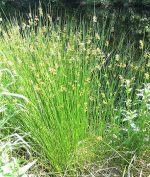 Also known as soft rush and mat rush, this herbaceous perennial is a member of the rush family, Juncaceae, that includes plants resembling sedges and grasses. Common rush is native to Europe, Asia, Africa, North American and South America where it is found in wet areas such a marshes, bogs, ditches, wet pastures, and along streams. The plants grow 2-4′ tall and form spreading clumps that may be considered invasive. The grass-like, green stems are soft, smooth, solid, and unjointed. Leaves are reduced to sheaths at the base of the stems. From July to September inconspicuous, scaly, yellowish green to brown flowers appear in spikey clusters on one side of the stem near the tip, and give way to an obovoid capsule. Common rush provides spawning area for fish, and food and shelter for for birds and mammals especially muskrats. It is a good choice for a wetland, bog, or wildlife gardens. The genus name Juncus, is the Latin word for rush. The specific epithet, effusus, is the Latin word meaning loosely spreading and refers to the growth of the plant.
Also known as soft rush and mat rush, this herbaceous perennial is a member of the rush family, Juncaceae, that includes plants resembling sedges and grasses. Common rush is native to Europe, Asia, Africa, North American and South America where it is found in wet areas such a marshes, bogs, ditches, wet pastures, and along streams. The plants grow 2-4′ tall and form spreading clumps that may be considered invasive. The grass-like, green stems are soft, smooth, solid, and unjointed. Leaves are reduced to sheaths at the base of the stems. From July to September inconspicuous, scaly, yellowish green to brown flowers appear in spikey clusters on one side of the stem near the tip, and give way to an obovoid capsule. Common rush provides spawning area for fish, and food and shelter for for birds and mammals especially muskrats. It is a good choice for a wetland, bog, or wildlife gardens. The genus name Juncus, is the Latin word for rush. The specific epithet, effusus, is the Latin word meaning loosely spreading and refers to the growth of the plant.
Type: Herbaceous perennial
Bloom: Inconspicuous scaly, yellowish green to brown flowers in spiky clusters in summer
Size: 2-4′ H x 2-4′ W
Light: Full sun
Soil: Wet including standing water up to 4″ deep
Hardiness: Zones 4-9
Care: Plants can become invasive making containment or removal necessary.
Pests and Diseases: Generally healthy but susceptible to rust, leaf spot and stem rots.
Propagation: Division of rhizome, seed
Companion Plants: Cattails, marsh mallow, purple loosestrife
Outstanding Selections: ‘Spiralis’ (twisted stems)
Photo Credit: Meegar Wikipedia